The Wolcott and Walcot Coats-of-Arms
Revised December 2025
These web pages are intended for genealogical research purposes only and may not be used elsewhere without permission, but linking is allowed without need of approval. Questions and additions or corrections may be sent to Eric Wolcott, (ewolcott6 at gmail.com).
The coat-of-arms of the Walcot family of Shropshire is found on the tombstone of Samuel Wolcott of Wethersfield, Connecticut, who died in 1734. It is also found engraved on a tankard which belonged to Gov. Roger Wolcott. Roger's grandson, Gov. Oliver Wolcott, Jr., had it on the seal he used to seal his personal correspondence.
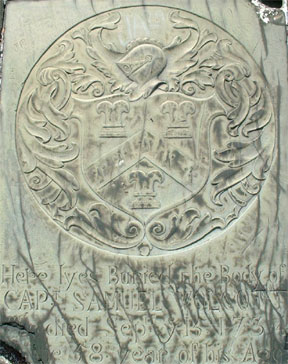
Tomb of Samuel Wolcott
A genealogy connecting Henry Wolcott, the immigrant, to the Shropshire Walcots was put together by H. G. Somerby in the 1850s, using the facts known at that time. The family's use of the Walcot arms encouraged him to produce a genealogy connecting the two families. This linking was described by Rev. Samuel Wolcott, author of the first Wolcott genealogy, as "conjectural". The Walcot coat-of-arms has been used by the Society of Descendants of Henry Wolcott for the past 120 years as its official emblem. Research done in England in the 1980s found no evidence to support any blood relationship. Recent DNA studies confirm that the Shropshire Walcots and the Somerset Wolcotts are two seperate families.
Although coats of arms had been used in England for a long time, the customs governing their use had been pretty loose until King Henry V issued the first law regulating coats of arms in England in 1417. It was then proclaimed that no one could assume arms unless he held them by right of inheritance or by the donation of some person who had the power to give them "except for those who with us carried them at the battle of Agincourt." Under English law, a coat of arms is the property of the individual to whom it is given, and descends in the male line to the eldest son. Verification of the right to use the arms is within the jurisdiction of the College of Arms, the official authority for authorizing English coats of arms. The College of Arms can also authorize the use of a variation of the coat of arms by a descendant other than in the eldest male line, as long as some part of the arms has been changed.
1. Walcote of Walcott, Norfolk. This family derived their surname from the village of Walcott, Norfolk. Sir Walter de Walcote c. 1290-1355, and his son, Sir Walter de Walcote, c.1330-1366, lords of Walcott and Gunton, used these arms: azure, an escutcheon between martlets in orle, argent; on a blue background, a silver shield surrounded by a circle of martlets. These arms are recorded in the Norfolk and Suffolk Roll of Arms, c.1400. The family is believed to now be extinct in the male line.
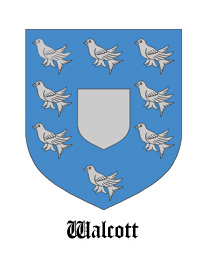
2. Walcote of Walcote, Leicestershire. This family derived their surname from the village of Walcote near Luttersworth, Leicestershire. The Surry Roll of Arms, c.1397, gives the arms of "Sir John de Walcote. Arg. on a cross patonce azure 5 fleur-de-lis or"; a silver shield with a blue cross, charged with five gold fleur-de-lis. Patonce crosses have each arm of the cross terminating in 3 points.
Froissant's Chronicles records that in 1380 John Walcott and several other men were knighted on the battlefield before the Battle of Troyes, by Thomas, Earl of Buckingham, who was commander of the English army. The Close Rolls of Richard II dated 1389 records that a petition of John Walcote, knight, was to be given attention in Leicester. In 1390 Sir John Walcott was sent to the Tower of London by the King's command. He was later transferred to the Marshalsea Prison for 3 more years. The Tower was generally reserved for political prisoners, so John must have opposed King Richard II. In 1399 Henry, Duke of Lancaster, deposed Richard II and assumed the crown as Henry IV. Henry died in 1413, and his son succeeded him as Henry V, of Agincourt fame. The arms "on a cross five fleur de lis" were on a window of the church at Smithsby, Derbyshire, a village on the border of Leicestershire. It is quartered with Shepey, Comyn, and Walleis for William Shepey of Smisby who married about 1430 Alice, daughter of Sir John Walcot and his wife, Elizabeth Walleis, heiress of the manor of Smithsby. The 1619 Heralds' Visitation of Leicester has a pedigree of the heirs of Alice's sister and coheiress, Margaret Walcot, who married John Danvers. This Visitation gives the Danvers coat-of-arms quartered with that of Walleis and Walcot, "Argent on a cross formee azure 5 fleur de lis or". Sir John de Walcote had only these two daughters and no male heirs, so the arms became extinct.
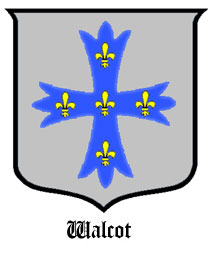
These arms also appear in the 1623 Visitation of Shropshire: "Joh'es Walcot de Walcot in com. Salop miles. anno 6 R.2; on a cross patonce azure 5 fleur-de-lis or". These arms were inserted in the Shropshire Walcot pedigree in error. The family used the arms, however, alongside their own arms. The 1863 Gentlemens Magazine article, Contributions to Local History - Bitterley, records Bitterley Court churchyard inscriptions, including: "John Walcot died Sept. 2 1700, aged 34; arms: 1. Argent on a cross fleury azure five fleur de lis or 2. Ermine on a chief three scallop shells.
"The1620 Visitation of Devon also records these arms, following the arms given for Wolcot, "Walcot, Аrgent, on cross flory sable five lis or, the crest a falcon's hed arashed argent gutty gules. Quere", meaning inquiry or question. However, the Devonshire Wolcotts were not related to the Leicestershire Walcotts either, and apparently never used these arms.
3. Walcot of Walcot, Shropshire. The 1623 Heralds' Visitation of Shropshire records "John Walcot of Walcot, anno 3 Henry V (1415), arms, argent a chevron between three chess rooks ermines"; on a silver shield, three chess rooks divided by a chevron ermined. Under King Henry V, who reigned 1413-1422, John Walcot of Walcott, Shropshire, married Matilda, daughter of Sir Richard Cornwall, Baron Burford, whose nephew, Sir John Cornwall, was married to the king's aunt. John Walcot was then granted a coat of arms, "a chevron between 3 chess rooks sable", which has since been used by the Shropshire Walcots.
An old story that the arms were granted because John Walcot beat King Henry V at a game of chess is unlikely. It seems more likely that the rooks were chosen because the Walcot estates were adjascent to the town of Bishop's Castle, Shropshire. A chess rook was traditionally shaped like and called a castle.
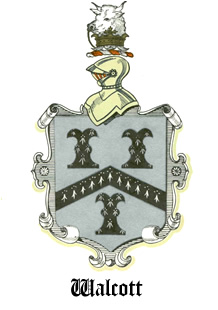
A volume of heraldry for the gentry of Shropshire and Worchestershire, dated 1676, gives these arms, "Walcott: Argent, a cheveron betwene 3 chessrooks erm. Som give on a fess sable, 3 escalops or."
The 1686 Visitation of Hampshire gives the arms for Mary Walcot, daughter of Humphrey Walcot and wife of Richard Bishop, as "a chevron ermine between 3 millrinds", a stylized millrind appearing quite similar to a stylized chess rook.
In 1819 Edmund Walcott of Winkton, Hampshire, the second son of of John Walcott of Croegh, County Limrick, was granted a variation of the Walcot arms and crest by the College of Arms: "Ermine on a chevron engrailed Azure between three chess rooks Sable three trefoils slipped Or. Crest: a bulls head erased Ermine armed Or gorged with a wreath of trefoils Vert in the mouth an arrow bendways gold." John's father, John Minchin, assumed the surname,Walcott, after succeeding to the estates of his kinsman, John Walcot, in 1736.
4. Wolcott als. Woolcott of Devon.
During the reign of Henry VIII (1509-1547), the College of Arms recorded arms for "Walcott: Per pale Azure and Gules on a cross patonce five martlets Sable on a chief Or a fleur de lis between two annulets Gules. Crest: A griffin head guttee de sang holding in its beak a fleur de lis charges with three bezantes".
Joseph Holland's Roll of Arms, dated about 1579, gives similar arms for "Walcot of Exeter". Hooker's Mss. 5827, written about 1580 and thought to have been copied from an earlier list, gives a variation of these arms for Wolcott, with the chief containing "a rose between two fleur-de-lis proper". Brooke's Mss. 28834, dated about 1587, gives the same arms as Holland for Wolcote.
During the 1620 Herald's Visitation of Devonshire, John Wollacott of High Bickington, Devon, registered this coat-of-arms and a family pedigree: "on a shield divided vertically blue and red, a silver cross flory with 5 black martlets, with a gold "chief" with a fleur-de-lis between two red rings; the crest a silver griffin's head with drops of blood, holding in it's beak a fleur-de-lis with three gold coins. A cross flory has the arms of the cross divided into three points. Martlets are heraldic birds, always shown without feet. Two early treatises on arms, one written in 1394 by John de Bado Aurea, and the other written in 1466 by Nicholas Upton, state that the martlet, when used on arms, indicated that the first bearer of them had acquired nobility by his own exertions or by the patronage of a Lord or King, since the martlet is shown without feet indicating that he had lacked foundations of his own to begin with. The griffin is a mythological beast, half lion and half eagle.
On the 1620 Visitation manuscript there is a marginal note referring to a manuscript of the Tudor period, which gave these arms for John Wolcott of Exeter. Another marginal note states that John Wolcot of Chudleigh and his son, John, did commonly bear the arms of Skerret (Or a chief indented sable). This John Wolcott of Chudley died at Exeter in 1549, and was the father of John Wolcott who lived at Exeter most of his life. The 1620 Visitation states that John Wolcott of Chagford, father of John Wolcott of Chudleigh, "gained great reputation for his good service in ye warres and as it is said had an addition given to his armes: on a chief or, a lis entre two annulets". In order to receive an augmentation, the recipient would have to have been an acknowledged bearer of a coat-of-arms. The fleur-de-lis on the augmentation of honor probably indicates that it was received for service in the Hundred Years War with France.
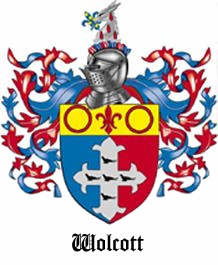
Burke's General Armory gives additional arms for the Woolcott family of Morston like that of the College of Arms, but with the shield silver, and for Walcot of Oxford like the College of Arms, but with the cross "patonce", perhaps differences for younger sons. These last two coats were used by descendants of John of Chagford's second son, Richard, brother of John Wolcott of Chudleigh. The descendants of Maximillian Wolcott of Knole House, Devon, also Richard's descendants, recorded with the Heralds' office similar arms with the cross of gold. Two other variations are known, one for Woolcot with a chief charged with a cross between two fleur-de-lis, and one for Woolcott with the shield red and a chief with a fleur-de-lis between two red crosses" formee", which may also be arms differenced for those not in the eldest male line.
OFFICIAL RECORDS:
In response to a inquiry from John Humphrey Walcot in 1988, the College of Arms advised that they held the following records:
C22-133 Pedigree of 14 generations headed by Johannes Wallcott of Walcot Shrop, whose great great grandson was married to Matilda Cornwall, with chess rook arms and crest; Dorset 1623.
C24-3769 Pedigree of 3 generations headed by Humphrey Walcot of Walcot and London, married to Alice Hale.
Gts 31-3000 Grant of arms to Edmund Walcott of Winkton, 1819, with modified chess rook arms.
C23-38/9 Pedigree of 5 generations headed by John Walcot of Walcot, Shrops., whose great great-grandson was age 3 in 1663, with chess rook arms quartered with arms of Carew, probably submitted by Sir John Walcot of Sherborne, Dorset, husband of Elizabeth Carew.
C14-229 Pedigree of 3 generations headed by Simon Walcott de Swanton, Co. Lincoln; Rutland 1619.
C23-69 Pedigree of 5 generations headed by Thomas Walcott of Walcott, Lincolnshire, with drawing of chess rook arms with crest.
D23-28 Pedigree of 4 generations, headed by Humphrey Walcott of Walcott, Lincolnshire, with grandson Humphrey Walcott who was age 70 in 1666, with chess rook arms.
2d G4-2b Grant of arms, temp. Henry VIII: Walcott : Per pale Azure and Gules on a cross patonce (tincture not shown) five martlets Sable, on a chief Or a fleur de lis between two annulets Gules. Crest: A griffen head guttee de sang holding in its beak a fleur de lis charges with three bezantes.
C1-74 Pedigree of 8 generations headed by Walterus Wolcott de Walcott, stating his son John Wollecott de Chagford “gained great reputation for his good service in ye warres and as it is said had an addition given to his Armes”; Devon 1620.
G2-4 Arms for John Walcote of Exeter, as given above, 1531.





